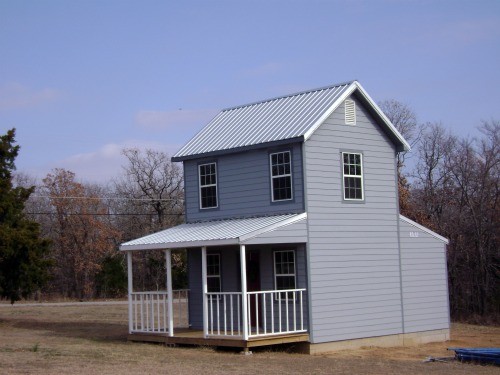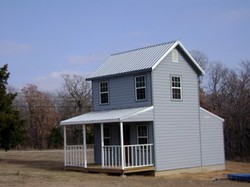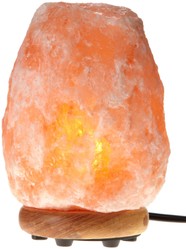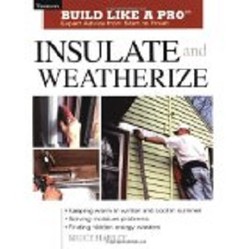
Tiny Houses: Redefining the Role of Housing in the American Dream
by jblack
A growing number of Americans are opting for a smaller slice of the American Dream by building and living in tiny houses.
 Author's Own Tiny House Larry Darter |
Home Ownership
Part of the American Dream
A recent survey conducted by U.S. real estate website Trulia.com revealed that 70 percent of respondents considered home ownership an important aspect of attaining the American dream. Yet the fallout from the bursting of the housing bubble ─ a sluggish economy, high unemployment, and tightened lending practices have placed traditional home ownership beyond the grasp of many Americans. Undaunted, a growing number of people are joining the fledgling tiny house movement as a means of fulfilling their own personal American Dream.
The Shrinking American Dream Home
According to the U.S. Census Bureau, the average square footage of American single-family homes grew from 1,660 square feet in 1973 to 2,519 square feet in 2008. "Bigger is better" seemed to be the continuing theme in American housing until the effects of the "Great Recession" began to take hold of the American economy.
By 2011, the combination of a sluggish economy, high unemployment, a wave of foreclosures, and higher down payment requirements had made home ownership an unattainable dream for many. By 2010, according to CNN Money, home ownership rates fell to the lowest level since 1965 with only 59.2% of Americans owning a home.
While economics wasn't the only force behind what some term the "tiny house movement," cost was certainly one factor in the burgeoning interest in constructing and occupying homes as small as 65 square feet. The Tumbleweed Tiny House Company founded Jay Shafer, a recognized authority in tiny house living, offers for sale more than 20 different construction plans for dwellings that range in size from 65 to 884 square feet. Shafer himself has lives an 89 square-foot home that he designed and built.
Exactly How Small is Tiny?
Micro home purists, those attracted to small house living primarily out of a concern for reducing their carbon footprint might argue that the cottages designed by Tumbleweed do not fit the definition of a tiny house. Yet even the largest cottage design, offering a rather reasonable 884 square feet of living space, is just over a third the size of the average for traditional homes in the U.S.
While there are some people who might easily adapt to living in a space under 100 square feet, others aren't ready to embrace downsizing to that extreme. In addition, contemplating the construction of very small structures comes with a unique set of problems. Many zoning laws prohibit the construction of homes that don't meet established criteria for minimum square footage in areas where such requirements exist.
Tumbleweed advocates building the tiniest homes on trailers to get around zoning laws but that too can produce another set of issues. Without the ability to build on a permanent location on a fixed foundation, getting connected to public utilities can be problematic. Owners must seek a location where sympathetic friends or family members living in conventional homes will allow them to connect to existing utilities. Otherwise, options are limited to choosing an "off the grid" setup with reliance on things like solar power, bottled gas, and composting toilets to replace conventional utilities.
Pros and Cons of Tiny House Living
There are benefits and drawbacks to micro home living and it isn't suitable for everyone. Still the advantages far outweigh the limitations for a growing number of people who have decided to join the home downsizing movement.
Advantages include;
- Drastically reduced construction costs. Obviously, the smaller the house being built the less building materials that are required. That isn't the only savings break though. "Sweat equity" is a real part of the tiny house equation since most people have the skills necessary to build them on their own, eliminating the necessity of hiring a professional home builder.
- Lower utility costs. It's a no-brainer that having less square footage means less heating and cooling requirements. By utilizing contemporary energy savings techniques, monthly utility costs can be an insignificant expense of home ownership.
- The need for mortgages can be eliminated. Many people drawn to the idea of building a tiny house choose to pay as they go. Since it is usually not feasible to obtain a mortgage to build such a small dwelling, typically self-builders pay for materials out of pocket. This might make for a relatively long project and delay occupancy but the upside is that at the end there will never be a monthly mortgage payment.
- Reduced property taxes. Since size matters when it comes to property tax assessments, the smaller the house the lower the assessment.
- Portability can be an advantage. For those who do choose to build a trailer- borne micro house, if they decide to move they can take their house with them. No need to ever worry about depressed real estate markets and they never have to look for housing in a new location. They just hookup to a towing vehicle and go.
- Greener living style. Tiny houses have a smaller environmental footprint and require fewer resources to build, maintain, and operate. This is a real plus for the environmentally conscious homeowner.
Disadvantages include;
- Location options are limited. Especially within the limits of incorporated cities, micro houses can't be built just anywhere.
- Utility issues. Conventional utilities might be unavailable for permanent structures except in carefully selected locations where public utilities exist and unfriendly zoning laws are not in effect.
- Lack of equity-building feature. For many, owning a home is not just about shelter. Except in economic climates like that which has existed since the housing bubble burst, homes have had a savings component in that they have been appreciating assets. A retiree might choose to downsize by selling the family home for far more than the purchase price and to use the gain as a supplement to retirement income. Tiny houses, especially in the extreme are unlikely to appreciate appreciably in value. Those built on trailers will likely lose value just like commercially manufactured mobile homes.
- Less room for stuff. Tiny house dwellers must embrace a simpler, more Spartan-like existence. There simply isn't room for things like mega screen televisions, king size beds, walk in closets, and living room sectionals. In fact, things that many of us take for granted like full-size appliances may be out of the question.
The Take Away
While tiny house living has its pros and cons, a growing number of Americans find the idea of living in one an attractive option. It is one option for achieving home ownership and a way to preserve that part of at least a scaled down version of the American dream.
Sources:
"News Room - Trulia.com - Press Releases." Trulia Media Center. Web. 04 Jan. 2012.
"Median and Average Square Feet of Floor Area in New Single-Family Houses." U.S. Census Bureau. Web. 04 Jan. 2012.
Christie, Les. "Home Ownership Falls to Lowest Level since 1965." CNNMoney - Business, Financial and Personal Finance News. 05 Aug. 2011. Web. 04 Jan. 2012.
You might also like
Himalayan Rock Salt Candle Holders and Lamps: Amber Glow of Ec...Himalayan rock salt candle holders and lamps generate lighting whose warm amb...
Insulated Windows: Saving Energy and MoneyUsing insulated windows or even just caulking the windows and doors around yo...






 Reasons to Learn Spanish as a Second Language with How to Guideon 01/13/2012
Reasons to Learn Spanish as a Second Language with How to Guideon 01/13/2012
 Women in Panties: History and Perceptionson 01/12/2012
Women in Panties: History and Perceptionson 01/12/2012
 Making Good Decisionson 01/09/2012
Making Good Decisionson 01/09/2012
 How to Plan a Great Vacation that Won't break the Bank ─ Part 2on 01/09/2012
How to Plan a Great Vacation that Won't break the Bank ─ Part 2on 01/09/2012



Comments
Lack of equity-building feature? That's a critical disadvantage. But if I had to choose between that and keeping a roof over my family's heads, I buy the tiny house.